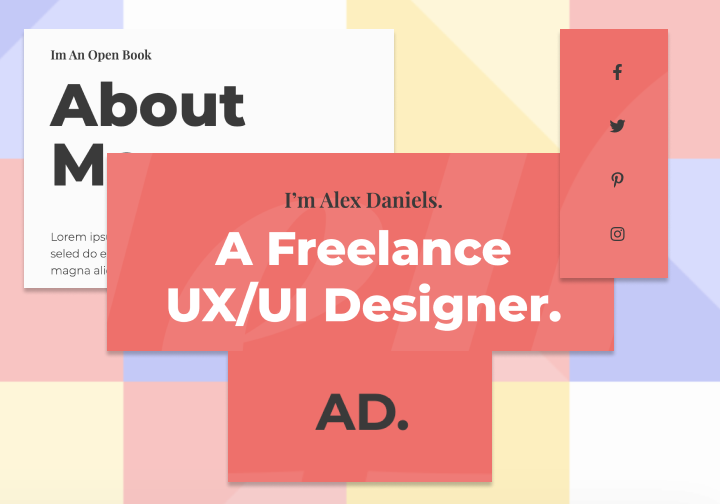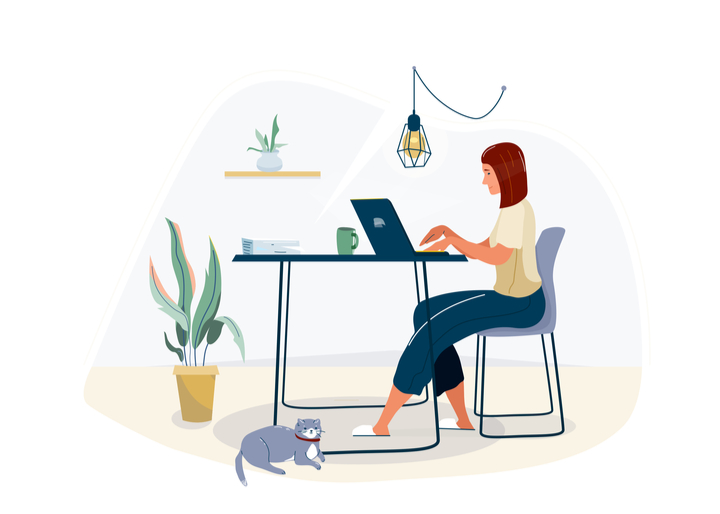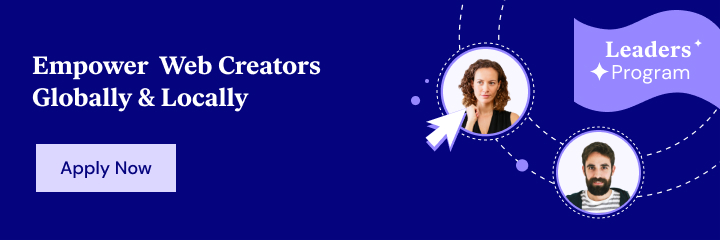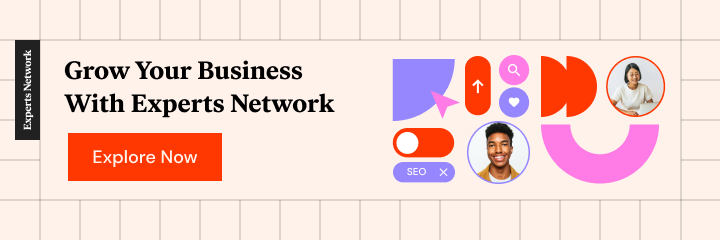Finding new web design clients is typically the biggest challenge that freelance designers and small agencies face. The competition is tough, and it can sometimes take a lot of work to promote your services and stand out in the market.
Even if you’re an excellent web designer with an impressive design portfolio, discovering the right ways to market yourself can be an arduous task.
But finding gigs and building relationships with clients doesn’t always need to be such a daunting undertaking. Let’s see how we can break down the process to make it as easy as pie.
Table of Contents
- How to Get Web Design Clients
- 1. Build Your Website
- 2. Gather Your Website Design Paperwork
- 3. Create Your Brand Identity
- 4. Leverage Social Media Communities
- 5. Promote Your Brand with Content marketing
- 6. Create Lead magnets
- 7. Network at Events
- 8. Become a star
- 9. Get Referrals From Satisfied Clients
- 10. Start Searching for Gigs
- How To Get Web Design Experience
How to Get Web Design Clients
1. Build Your Website

The way we see it, it’s a non-negotiable rule of thumb: Every web designer, whether freelancer, employee or owner of a web design business, needs their own website.
It may sound daunting to create your own website from scratch, but it can really be a lot simpler than it sounds. And it’s super important for several reasons, which is one thing we’re going to address in this post.
Whenever a prospective client takes an interest in your work, it’s likely to assume that the first (or one of the first) thing they’ll want to see is your website. And you definitely want to provide what they’re asking for.
The last thing you want to happen is for a prospective client to search for you on Google, struggle to find your website, and then choose a different web designer instead. The best way to avoid this type of scenario is to invest a lot of time and effort into designing your website.
Once your website design and SEO are in good shape, the prospective clients searching for you will be impressed with what they see.
Now for some practical tips, planning to create your first website can be quite simple.
First, we recommend getting your feet wet in the world of WordPress, which means getting a domain name, finding a site host, etc. You can learn all about how to set up a WordPress site with this video tutorial and post.
Then, once you’ve set up this infrastructure, you’ll move onto the next step: Setting up the website itself. Once you do these, you’ll finally be able to start the design process, both visually and functionally. The optimal (and easiest) way to do this is by downloading plugins, such as Elementor Page Builder and Yoast, for designing your site, optimizing SEO, and so on.
You may find it helpful to see our series of video tutorials that shows you exactly how to download the Elementor plugin and start using it to design each page and post on your site.
After you finish this, your website should be up and ready to roll, and you can finally start doing what you need to do to attract your new clients.
2. Gather Your Website Design Paperwork

Lorem ipsum dolor sit amet, consectetur adipiscing elit. Ut elit tellus, luctus nec ullamcorper mattis, pulvinar dapibus leo.
Draft a Website Proposal
A website proposal is a written agreement between the service provider (in this case, you, the web designer) and the client. It’s similar to a business contract, which we will address later in this post. But, it’s different than a contract in that it addresses your mutual expectations with the client about what work you will provide them, how much it will cost, etc.
In practice, how do you know what to put into your web proposal, especially at the very beginning of your web design experience?
Before you start drafting the actual proposal, a lot of research is required of you, the web designer.
This will include the following steps:
- An in-depth interview with the client
- Listen to the client’s needs
- Evaluate your abilities and expertise
- Evaluate your resources and materials
- Evaluate your availability
In our recent blog post, How to Write Great Design Proposals, we delve into greater detail of all these steps involved in the research needed for your proposal.
In fact, we have several resources that will help you and make the process even easier:
A recent episode of our Monday Masterclass: How to Write a Website Design Proposal
In this masterclass episode, you can learn everything you need to know about what goes into a website work proposal: thorough research, how to compose the proposal, pricing, and so on.
Next off, we’ve also created a free downloadable sample proposal, which you can download by clicking below:
Write up a Sample Contract
Next up, you’ll start the real business side of things: writing up a sample contract. Every service you provide must have a written contract backing it up. This will only work in your favor. The key benefits, as we see it, in making sure you have a written contract before taking on any web design project are as follows:
- It saves you time
- It saves you money
- It saves you aggravation
When you’re first starting out as a freelance web designer, the task of writing up a web design contract can seem daunting, to say the least. But it doesn’t need to be that way.
We recommend taking the following steps when writing up your contract:
Have a clearly defined statement of work
This is a crucial section of your contract because, as the saying goes, the client (customer) is always right. If you don’t know what the client is expecting from you, it’s very possible that he won’t be satisfied with your work once you’ve completed it. A statement of work also enables you to understand and clearly define the scope of the project (to avoid scope creep) what the time frame for completing it (well) will be.
Streamline the review and approval process
One thing you definitely want to avoid is sending the client a substantial amount of work that you’ve done, and then not hearing from them for ages. Once your contract specifies the number of days the client has to review designs and get back to you, you can avoid delays and miscommunications that result in projects that fall through the cracks.
Protect yourself in the case of project termination
There are many circumstances that could cause a project to be terminated. This could be in the hands of the client (his decision to terminate) or by an unexpected event that isn’t in their control. In either case, including a clause in your contract which protects you from losing your income in the event of project termination is a must-have.
Protect yourself from copyright infringement
In the relationship between a web designer and their client, one example of copyright infringement could take place is if a client pulled a photo or visual of yours off of a Google image search and included in the assets to go on his new website.
If this happens, you will want the legal grounds to protect your digital property? And make sure you maintain the ownership you’re entitled to.
Consult with an attorney and designate a legal jurisdiction near you and address it in the contract
In the worst-case scenario, there are situations where a web designer and their client have a conflict or disagreement and end up in a situation where one party sues the other.
If you are the party being sued and haven’t designated a legal jurisdiction in your contract, you may end up having to travel to the client’s (the party filing a lawsuit) legal jurisdiction of choice. This is certainly not a situation that you want to find yourself in.
For these reasons, you’ll also want to consult with an attorney before finalizing your contract. It’s always good to have an expert make sure that you’re protecting all of your rights and aren’t risking being in trouble later on.
3. Create Your Brand Identity

Why It’s Important to Build Your Personal Brand
Personal branding is a key ingredient for any web designer who wants to excel at their craft. Why so? For starters, creating a personal brand is about forming an identity as a designer. It’s how you stand out among the crowd, among the competition. And as most of us know, the competition is fierce.
The way we see it, your branding is:
- How you present yourself to your ideal audience
- The image you put forth
- The thing that makes you unique and sets you apart from your competitors
- The value in what you offer as a web designer
- A visual representation of all the items listed here
When prospective clients are searching for a web designer to build the website of the dreams, they’re going to want to look for a designer whose style and personality matches the type of website the client is looking for.
So, finally, what exactly is a brand identity for a web designer? What should it include?
If your design work and personal style is well represented by bright colors, bold fonts, etc., your website might be very appealing to, for example, an independent fruit drink company looking to market their products with a vibrant, fruity theme. They’ll probably be more drawn to your brand style than to a designer whose website uses an elegant, traditional black and white color scheme with a logo written in calligraphy.
Both brand styles are great in their own right, but each of them represent a different type of design personality. You may know that you’d be a better fit for designing a website that displays brightly colored fruit products, rather than a ballet school agency showcasing their timetable and recital photographs.
If this is the case, choose the branding style that fits your personality and design samples, so you can really connect to what your future clients will need.
How to Identify Your Web Design Niche
Focusing on your niche audience can make it considerably easier to find web design clients as well as help them find you.
So how can you figure out what your niche should be?
First of all, what interests you? Are you a seasoned online shopper with a lot of experience in E-commerce? Are you a yoga-enthusiast who likes designing websites related to sports and exercise?
Aiming to find website design projects that are related to subjects and industries that you’re familiar with can be a game changer for two reasons (among others):
- You may already have contacts or communities in your areas of interest that can refer you to clients (testimonials are really important at this stage).
- Your design projects will almost always be stronger if they’re connected to a topic that you’re interested in and/or passionate about
This is also a good thing to keep in mind when creating your web design portfolio. Choose projects, even sample projects, that are connected to things you have knowledge and experience in. The results are bound to be stronger, and you’ll enjoy the process more, too.
We’ll get to the value of community-building and leveraging social media to for fine freelance web design work later on in the post, but while on the topic of ‘finding your niche’, it’s important that we understand just how vital communities can be to finding your niche, and not only crucial to networking, but to finding freelance work altogether.
Tapping into communities built around a niche you’ve identified, such as E-commerce, for example, can teach you a lot about the types of clients you’re targeting.
Let’s say, for example, that you’re really interested in building websites related to fashion and E-commerce. You then decide to join a Facebook group built for owners of retail clothing store owners who use the group to share tips and experience about the industry.
If you’re exposed to the topics they’re discussing and the challenges they’re commiserating about together, you may have a better understanding of E-commerce website trends, what types of personalities work in the industry, what kind of store owners are struggling and what kind are more successful, and so on.
Getting first hand exposure will give you a strong advantage for understanding the type of clients you’re looking to meet and build relationships for.
4. Leverage Social Media Communities

Social Media Platforms
The more you spend time building your presence as a web designer on social media, the more your career will thank you. Web designers spend tons of time communicating, sharing expertise and work samples, and most importantly posting projects they’re looking to hire for and recommending fellow designers. In the online world we live in, one of the best ways to meet the people you want to work for is to communicate with them and connect with their peers.
Facebook is especially resourceful for web designers and freelancers in general because of the groups that people create, whether they’re region-based, topic-based, or just general web design groups. They’re open to people anywhere in the world, often people you would never come across if it weren’t for a social network such as Facebook.
You’d be surprised at how many recommendations and referrals web designers get on Facebook, where word of mouth spreads like wildfire. You can follow influencers, meet people in the niche you’re looking to tap into, and more. Even if at the beginning you’re just an observer reading discussions that people are having, you can learn so much about what’s going on in the industry, what the web design market is like, and how you can dive into it.
The traditional use-case for LinkedIn is recruiters and managers posting jobs that they’re looking to fill. But this doesn’t mean that freelance designers have nothing to gain on LinkedIn.
First of all, it’s a great way to get your name out there, as you can connect with tons of professionals, even if they’re not necessarily looking to hire freelancers in the near future.
You can market yourself as a professional web designer, post links to your projects, post articles (either ones that you’ve written or ones that you’ve read and find inspiring), and create a following.
Reading articles and content shared by others in your network is also really helpful, so you can find out what people are talking about, get familiar with web design trends, and even create sample projects based on what you see is popular. The opportunities are endless.
LinkedIn Groups are also great. Similar to Facebook groups, you can join and be exposed to very niche discussions that other professionals are having. Knowledge is power.
At Elementor, we’re big fans of Instagram. From hashtags to influencers, there is so much exposure that you can learn from, and that you can gain once you build up a following. It’s also just a fun way to see what’s going on out there.
You can show off your work, share real photos and visuals that let people get to know you both personally and a professional, and of course, see what topics are buzzing and what you can learn from the experts.
Dribbble
Dribbble is “The Community for Designers.” It’s an ecosystem where web designers can do several wonderful things:
- Showcase their work
- See other designers’ projects for inspiration
- Search the Dribbble job board for full-time job openings
- Get hired for web design projects
- So much more
Because the essence of what Dribbble was created for is to be a place where designers exchange their best work, either for community-building, competitions, learning from influencers, blogging and so on, their content addresses the exact needs of what web designers need to grow their career.
Behance
Behance is another community built exclusively for designers (owned by Adobe), geared at letting them showcase their best work. Behance is a great place to put your projects in the spotlight. You can upload every visual element you’ve created, and gain credibility and prestige as a true web design professional.
It’s even a great platform to use as a portfolio that lets you upload your projects and then refer potential clients to them. If you’re just starting out as a web designer, posting your work on Behance is a great way to get your feet wet and start building your online design presence.
Even if you still don’t have enough material to create a full-fledged website with a substantial number of projects.You can post your design work to Behance as you finish them, and once you have the resources (time and completed projects), you can devote time to your personal website and portfolio.
But even once your website and portfolio are up and running, we suggest continuing to post your design work to Behance in parallel. It’s a great place to meet people and let other Behance users know what you’re all about as a designer.
5. Promote Your Brand with Content marketing
Having a website is essential, and every site has content. However, great content is king and an excellent inbound marketing tactic. Having a blog, for example, can significantly boost your efforts to reel in potential clients. If you have a blog or want to start one, identify your niche to differentiate yourself from the competition and dictate the type of clients you wish to attract.
This process helps you choose pertinent topics to write about, addressing your niche audience’s pain points. Also, through writing, you position yourself as a thought leader in your field. Maintaining blogs can further boost your SEO and push you up the search engine ranks. Conduct regular keyword research to see how you can grow your audience and reach clients.
Content and the prospects that accompany it not only refer to your website. Social media is a crucial part of extending your reach to potentials and widening your audience.
Content Marketing on Social Media
Social media is where most people ‘hang out.’ Identifying where to put your effort reverts to knowing your niche audience. Your niche also includes industry/field, age, and other parameters. If your design specialty lies in creating serious sites for SAAS providers, LinkedIn might be your best option.
On the other hand, if you have vast experience in fun designs for online clothing and accessory providers for teens, their target audience would most likely be hanging out on Pinterest or Instagram. Why is this knowledge necessary? Because you should tailor your content on different platforms to your potential clients and their end-users.
The leading platforms to target are:
- Facebook – Create a professional-looking company page with examples of your work. Encourage likes and shares.
- Instagram – Perfect visual platform to create a virtual portfolio, show individuality, and use targeted hashtags.
- LinkedIn – Try the LinkedIn Recruiter tool, which uses keyword logic (e.g., Freelance Web Designer) that lets businesses find recruits. Include examples of sites or landing pages you’ve designed and recommendations.
- Pinterest – Construct gorgeous boards of your work. Re-pins increase exposure!
6. Create Lead magnets
A great way to create sales leads is to use what marketers call a “lead magnet.” The purpose is as it sounds – drawing prospects in like a magnet by getting them to the point of sharing their contact details and turning them into customers.
You can achieve this by delivering content that is not otherwise available. In other words, the best magnet is offering something for free. Who can resist giveaways or freebies? Even serious businesses want to ‘try before they buy.’
For example, You could offer access to a great e-newsletter that discusses the industry, the latest web design trends, and links to more information at publicly available resources. If this will take too much time, use an email automation client and your RSS feed to collect your blog articles into a daily, weekly, or monthly newsletter.
Some great ideas for designers are to offer a free consultation, provide free templates, and even guidebooks for fellow designers or potential clients. In addition, you can advertise special offers on different platforms and even use paid campaigns that lead to a stunning landing page.
7. Network at Events
It’s not cold-calling, but let’s call it in-person cold-pitching. It’s one thing to hide in your office and try every marketing tactic to put yourself out there. It is another thing to introduce yourself face-to-face and try to sell yourself. The latter takes some courage and much self-belief. However, the power of “swapping business cards” still has much sway.
So how do we put this into effect? Attend conferences and events! Events are opportunities to invest in your business. By meeting new people, making connections, and networking, you boost your visibility. You may discover new networks, find potential partnerships and co-marketing prospects, and hopefully bag some new clients.
Moreover, by speaking to you in person, potential clients won’t think of you as just another of the hundreds of freelancers vying online for a spot in the sun. You can build a relationship of trust and share your expertise.
Choose the Events Where Your Audience Is
The events you choose, especially if your budget is tight, should be industry-specific so, web development. Also, don’t miss networking events and target meetups where you know your perfect audience will be. Becoming a familiar face at industry-specific events lets you stand out from the crowd when companies seek a web designer.
If you’ve amassed a collection of contact details and met many people of interest, take serious networking to the next level. Add the most potential leads on LinkedIn, so they don’t forget you. You may drop them a note to say it was a pleasure to meet them and you’d be happy to provide your services.
Keep Track of Who You Meet
Consider creating a spreadsheet. Update it after every event, writing the names of whom you met, their specialty, their role in their organization, their pain points if you discussed them, their business objectives, and a reason to stay in touch – and then do it!
8. Become a star
We’re not talking Hollywood, but one of the most excellent ways to boost your business and earn your place in the limelight is by becoming a public speaker. You will promote your brand by demonstrating your expertise in the industry. However, this is easier said than done.
Making guest appearances at events, or in these times, more likely via podcasts and webinars, can be daunting. In addition, many people suffer from anxiety when it comes to public speaking. Start small by approaching networking event organizers looking for people to share their experiences in the field and fill up time at events.
As you gain experience and gather more opportunities to speak, you can reach a broader audience. Eventually, you can appear at more significant events and become a sought-after speaker whom organizers approach without you having to pitch!
9. Get Referrals From Satisfied Clients
A large part of success in any industry and especially for freelancers trying to land gigs is word-of-mouth. Getting clients who are delighted with your work and ready to rave about it means future referrals and business growth.
Finding those clients involves all of the sections mentioned in this article. It takes hard work and dedication, but people would prefer to work with someone referred to them – be it by a colleague, friend, or even by seeing your name on a competitor’s website.
Even if your work is excellent and your clients are thrilled, they probably won’t think of volunteering to write a recommendation on your LinkedIn page. Though this is definitely something you should ask them to do via the LI request tool. Anyone reading your LI page will look at references.
Collect Testimonials on Your Website
You can also have a place on your website – or your FB business page featuring quotes from happy clients. Ensure that the quotes are actual with the recommender’s name and organization and don’t sound like you wrote them yourself. Perhaps you could put a picture of your client or have a link to their site to increase transparency and generate trust and credibility.
Don’t be passive. Email or call past clients and ask if they know anyone who needs your services. This is how word-of-mouth starts!
10. Start Searching for Gigs

Getting to Know Freelance Marketplaces
The creation of web designer marketplaces such as Elementor Experts, Upwork, Fiverr etc. have changed the professional landscape for web design freelancers. So much so that 73% of freelancers look and find jobs on freelance marketplaces. Over the past few years, these marketplaces have become a staple for businesses looking to hire freelancers, and a go-to option for independent professionals looking for web design projects.
Freelancer marketplaces, in fact have introduced a new era to borderfree business collaboration, as freelancers can do work for clients on opposite sides of the globe, no matter the timezone or location.
Understanding the Client’s Perspective
Clients looking to hire using freelance marketplaces because it makes the logistical side of the recruiting process significantly easier. This is also true for finding the ‘best man for the job’. Marketplaces often have high acceptance criteria where their profile and portfolio have to be accepted by website authorities or admins, so clients can be assured that they can rely on the designer’s credentials and capabilities. Saving time on the hiring process is a huge incentive for business owners.
This censorship actually works in both the client’s and the professionals favor, since the client knows he’ll be working with someone trustworthy, and the professional has gained a level of credibility for their future gigs.
On a global scale, 30% of Fortune 500 companies hire through Upwork. This indicates just how mainstream it has become for web designers to consider freelance marketplaces (Upwork, and many others) as a go-to option for growing their expertise and career.
Elementor Experts
Elementor Experts is our newly launched discovery network for web creators. It’s a platform for designers, marketers and developers to showcase their work and get hired for projects. And the signup process is super simple and easy.
Once you create a profile, you fill in some quick details about yourself, select the languages you can work in, check off the services you provide, and add projects to your portfolio. Once you cover these bases, you’ll become available for web design freelance gigs.
Until clients start contacting you on the platform, we recommend using the time to add more and more sample projects to your portfolio. The more work samples you have, the better. Prospective clients always want to see what kind of work you can do and how experienced you are in the field.
Upwork
The sign up process for Upwork requires more work and effort (and you have to apply and be accepted by the platform), but the client base and number of job listings are so vast that it’s definitely worth the effort, even if you have to resubmit your Upwork application (as many do).
Sites like Upwork are especially useful for web designers who are at the beginning of their freelance career, and looking up to build up their portfolio as well as their client base. You can start with small, lower-paying gigs, and keep working until you start taking on advanced projects that provide a substantial source of income.
Yes, It does take work to break into the Upwork community, but we see it as an investment to be made.
Similar to Elementor Experts, you have to input what skills you have when applying to Upwork. However, what’s different is that the recommended number of skills to check off when applying to Upwork is a maximum of two. The idea is that you want to position yourself as a specialist in your expertise, and candidates that check off too many skills may arouse suspicion that not all of their skills are really qualified for.
Fiverr
Fiverr works a little differently to your average freelance marketplace — in terms of their terminology for how you present yourself to people looking to hire.
You start out by becoming what they call a ‘Seller’, and posting gigs that you can be hired for from scratch. Unlike more traditional marketplaces where your profile informs visitors of your the services you provide, on Fiverr you create actual gigs as if they’re a product that you’re selling.
You’ll then become visible on their marketplace, and potential clients view your profile to see if your gig is what they need, and then they’ll propose an offer for how much they’d like to pay you for what you’re ‘selling’.
Getting hired for projects on Fiverr requires some out of the box thinking as you’re presenting yourself based on who you are and what you do, rather than showing that you meet the exact criteria that a client is looking for.
What’s great about Fiverr’s hiring technique is that you can take your web design profile to the next level. You have a clean slate to identify yourself in a unique light. Rather than answering questions of what boxes you fit into, you create your own identity.
Instead of selecting “I am a Web Designer and my skills include WordPress, HTML and CSS, you can present a more unique identity for yourself. An example of this could look something like “I’m a seasoned web designer. I specialize in responsive design, so I’ve invested a lot of projects in HTML and CSS, to make seamless, mobile-friendly websites.”
This can be a fantastic way to stand out among other web designers.
How To Get Web Design Experience
One of the major problems of people who are starting out in any profession is experience. To get a job somewhere, you need experience, but to get experience, you need to work and hone your skills. It’s an endless, co-dependent cycle that can become frustrating.
Luckily, we have some ideas on how to get you started.
Create a Web Design Portfolio
To show your experience, you need to create your own design portfolio — to show potential clients and employers just what you can do. Start by building your own website, invest your time in it, and make sure it’s done well. This will, after all, be your crown jewel — the showpiece that will exhibit your skills (at least until you create something even better in the future).
This approach will also require you to invest some money (in the upkeep of the website, in purchasing the appropriate tools, etc.) but as the saying goes, you’ve got to spend money to make money, no?
Provide Pro-Bono Design Services
In order to gain valuable web design experience, it’s sometimes necessary to provide volunteer services. You can offer your skills for free to:
Friends and Family
You may have friends or family members who need a website. Why not approach them and offer them to design the website for them? Some may be willing to pay you something for your work, but for the most part, this approach will not generate income.
It will, however, give you a canvas to work with, and at the end, a result to show (not to mention, some very positive reviews from those who are close to you).
Other Professionals
Another good idea would be to partner with other professionals (web developers, for example), who also need to showcase their work. You could find someone like that, and offer to work on a website. They will showcase their skills in the development department and you will showcase your skills in the design department.
Nonprofit Organizations
You can also find nonprofit organizations that need help with their web design. As organizations that don’t run on money, but on volunteer work, your help will be most appreciated. At the end of the day, you will have showcased your work and helped those in need — what could be better?
Good Luck With Your First Gig!
Now that you know exactly what you need to do in order to onboard new web design clients, it’s time to get started. The competition can be fierce for web designers, but there are so many resources and tools that make it much easier for you to gain the credibility you need and meet the right people.
Keep in mind that slow and steady wins the race, so it’s sensible to take on simpler projects (that are also easier to get hired for) at the beginning and gradually widen your work scope to more advanced projects with higher demands.
Every design gig you land counts towards the next one, so we like to think of it in terms of the big picture. But this also doesn’t mean that you should take any and every freelance job you’re offered.
Choose your clients wisely, and invest yourself in those that appreciate the value of web design, and that you can envision long term relationships with.
Let us know what kind of projects you find, and show us what you come up with!
Looking for fresh content?
By entering your email, you agree to receive Elementor emails, including marketing emails,
and agree to our Terms & Conditions and Privacy Policy.


